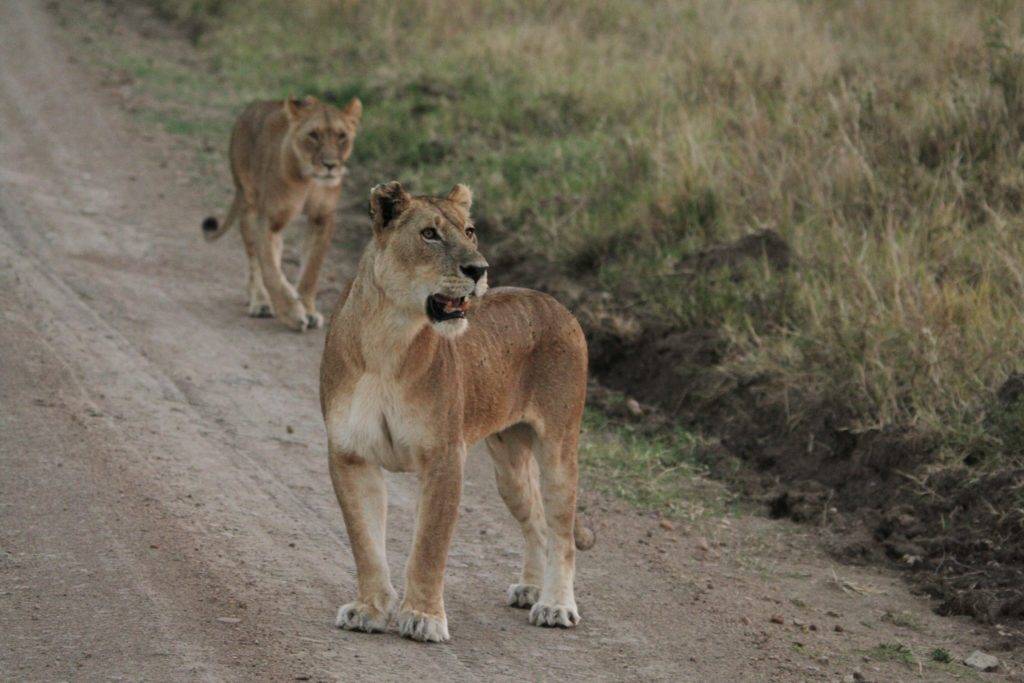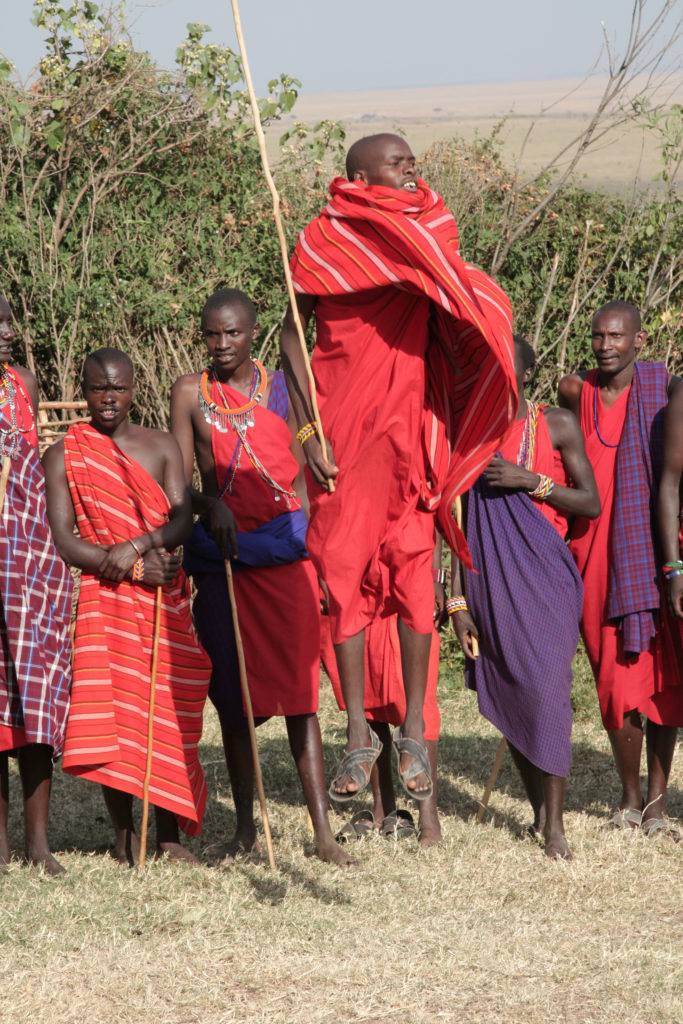Lions, giraffes, zebras and hippos were everywhere as our Safari Link plane approached the dirt runway. It was obvious that the Maasai Mara had amazingly abundant wildlife, almost everything we hoped for, except for rhinos. Illegal poaching has reduced their numbers dangerously close to zero. Sightings only seem to come now in small, protected areas where the animals are more captive.
Our 40-hour journey to start our adventure began in Regina, Saskatchewan, Canada. We left on Air Canada, connected to Lufthansa in Toronto, had an 8-hour wait in Cairo to connect onto Egypt Air to get us into Nairobi late at night, with a shower and short nap available in a home there. Then back to the airport before sunrise and onto a small Safari Link plane to the Maasai Mara Game Reserve to begin our 3 weeks travelling through Kenya, Tanzania, Zambia and Botswana. For the rest of our trip we were mostly in jeeps but also some more small planes, motor boats and even a hot air balloon for our daily safaris and travels.
In addition to exploring the Maasai Mara Game Reserve, the photos here are also from Kensington’s Mara West Lodge in Kenya, the Ngorongoro crater and the Serengeti in Tanzania, Victoria Falls in Zambia, and Elephant Valley Lodge and Chobe National Park in Botswana.
We also visited a Maasai village one day, besides our daily safaris. As we arrived, the women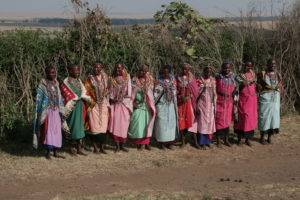 performed a welcome song and dance. The men followed this performance with a jumping competition. This involves chanting and jumping straight up and down. The women stay nearby, watching, as apparently the higher you jump the more girlfriends you attract. I joined them to give it a try and proved that white men really can’t jump.
performed a welcome song and dance. The men followed this performance with a jumping competition. This involves chanting and jumping straight up and down. The women stay nearby, watching, as apparently the higher you jump the more girlfriends you attract. I joined them to give it a try and proved that white men really can’t jump.
The Maasai always wear red as they believe lions don’t like that colour so it helps to protect them. The men also all carry a stick at all times. I think it’s multi-purpose, helpful in herding their cattle (the Maasai believe that they own all the cattle in the world), and perhaps a weapon, although they are experts with a bow and arrow.
They make a huge variety of carvings, jewelry and other art and handicrafts. The proceeds from selling these items helps to pay for schooling and to buy cattle. In the not too distant past, they increased their herd mainly by raiding other villages.
Our guide to the village was Gideon, the grandson of the village’s 102 year-old Medicine Man whom he is training to replace one day. He brought us into his mother’s home made out of sticks and cow dung; we were immediately covered with flies after entering. It was pitch dark, divided into three rooms separated for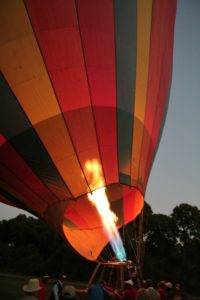 sleeping and cooking.
sleeping and cooking.
Our third day started before sunrise with a jeep ride into the wilderness. We arrived in time to watch our hot-air balloon be prepared for a 90-minute ride across the plains, rivers and forests skimming the tree tops. Our captain stayed in communication with a ground crew, following us across the tundra. They had a champagne breakfast set up for us out in the wilderness where we landed.
There were so many wonderful, close, exciting lion experiences from our first night in the Maasai Mara. Throughout the Serengeti and Ngorongoro caldera, and in Chobe National Park in Botswana as well. We felt so privileged when lions allowed us to sit near them. We could watch them relax, mate, eat, care for their young, and hunt.
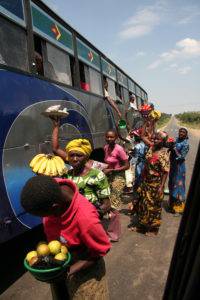 Setting out early in our jeep one day after four nights in our tent/cottage at Mara West Lodge, we were in for a very long, bumpy, and dusty drive to our tenting location in the Serengeti in Tanzania. Our journey took us through several small towns with huge numbers of people walking along the road with shopping or laundry on their heads. Women were doing laundry by hand on the shore of every river and stream, even in puddles at the edge of the road; wherever they could find water.
Setting out early in our jeep one day after four nights in our tent/cottage at Mara West Lodge, we were in for a very long, bumpy, and dusty drive to our tenting location in the Serengeti in Tanzania. Our journey took us through several small towns with huge numbers of people walking along the road with shopping or laundry on their heads. Women were doing laundry by hand on the shore of every river and stream, even in puddles at the edge of the road; wherever they could find water.
After a few days of jeep safari around the Serengeti, we drove on to Zambia and stayed a few nights at the upscale Victoria Falls Hotel. We enjoyed a river cruise on the Great Zambize River, and rode an African Elephant through the jungle.
We continued on towards Botswana, feeling refreshed from our stay at a nice hotel. Our last leg of the journey was on a small boat at the wildly busy border crossing, then into another jeep on the Botswana side.
Nile Crocodiles, up to 6 metres long and 1,000 kg were in every stream and river. Most 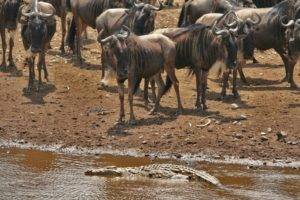 often, trying to imitate a log near the shoreline, waiting for an unsuspecting Wildebeest or other animal to linger a little too long while drinking.
often, trying to imitate a log near the shoreline, waiting for an unsuspecting Wildebeest or other animal to linger a little too long while drinking.
We had some particularly good photo ops of crocodiles one day from a small boat on the Chobe River. Moving slowly into an area of shallow inlets and mud flats, amongst a large group of Nile Crocodiles, our steering linkage suddenly broke. We 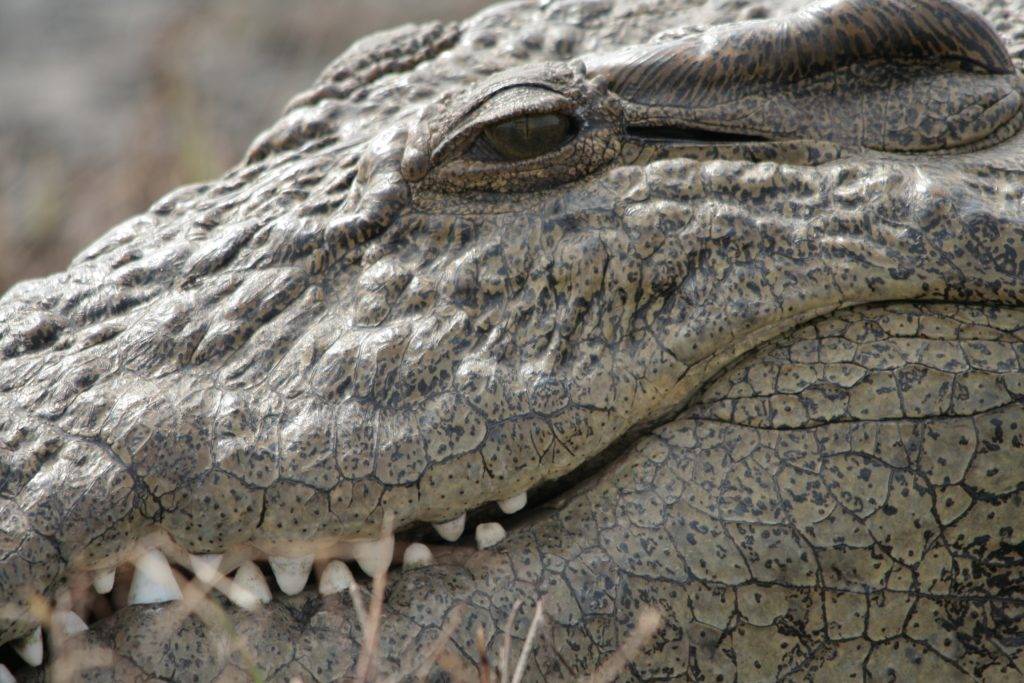 drifted helpless for nearly two hours, surrounded by crocodiles. I put away the telephoto as our boat bumped up against the shore within a few feet of some of the largest Nile Crocodiles we had seen. Another boat finally came to save us. We held the boats together as we crossed over then continued on our way. Our savior stayed behind in the dead boat which he had to repair in order to make it home again.
drifted helpless for nearly two hours, surrounded by crocodiles. I put away the telephoto as our boat bumped up against the shore within a few feet of some of the largest Nile Crocodiles we had seen. Another boat finally came to save us. We held the boats together as we crossed over then continued on our way. Our savior stayed behind in the dead boat which he had to repair in order to make it home again.
Chobe National Park in Botswana is home to around 125,000 elephants. We frequently had to stop our jeep and wait while they crossed the road in front of us. We often saw lone elephants, or herds, at a water hole drinking, or spraying themselves with water to cool off and sand and mud to protect their skin from parasites and the sun.
had to stop our jeep and wait while they crossed the road in front of us. We often saw lone elephants, or herds, at a water hole drinking, or spraying themselves with water to cool off and sand and mud to protect their skin from parasites and the sun.
The herds in Chobe National Park were made up of anywhere between 10 and 60 elephants led by a 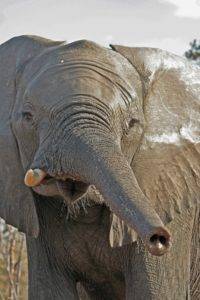 dominant female. They would often walk all around and right beside our open jeep as we watched each other.
dominant female. They would often walk all around and right beside our open jeep as we watched each other.
In Botswana, we stayed at Elephant Valley Lodge with nice tent/cottage accommodations. A very active water hole was right in front of us so we had front row seats to a wide variety of animals each day.
Our last day was a jeep safari and we ended up following a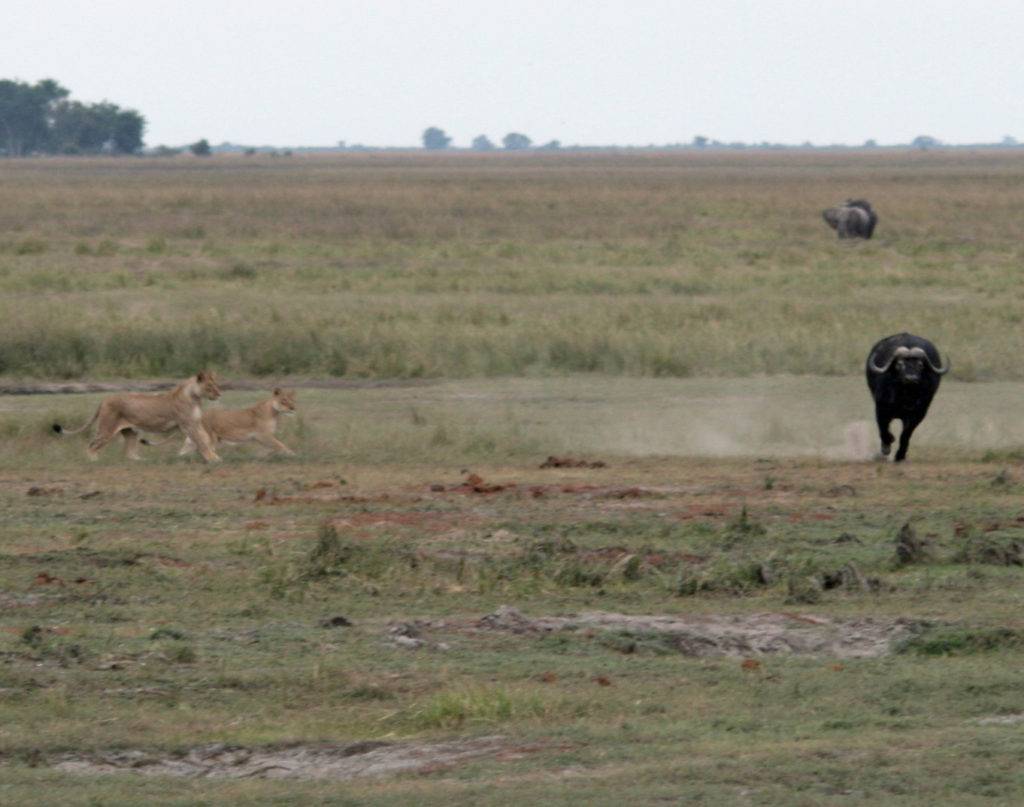 pride of lions while they hunted buffalo. The inevitable chase was thrilling but we were also very happy that it was unsuccessful.
pride of lions while they hunted buffalo. The inevitable chase was thrilling but we were also very happy that it was unsuccessful.

